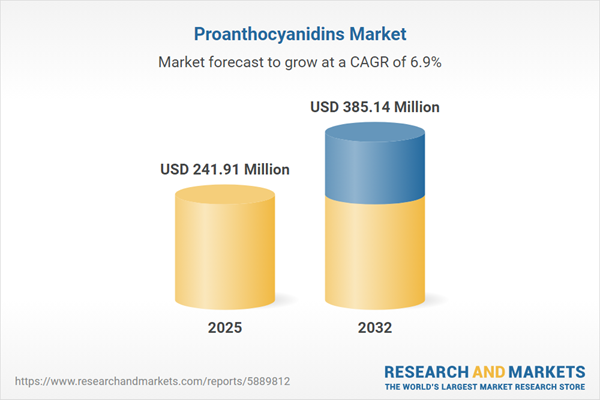Speak directly to the analyst to clarify any post sales queries you may have.
Proanthocyanidins are establishing themselves as critical tools for health-focused organizations intent on delivering value through wellness, sustainability, and innovative offerings. As industries pursue these outcomes, a strong understanding of the evolving proanthocyanidins market is essential for sustained leadership and competitive advantage.
Proanthocyanidins Market Snapshot
The global proanthocyanidins market is valued at USD 226.32 million in 2024, recording a compound annual growth rate (CAGR) of 6.87%. Robust expansion is influenced by increased use in dietary supplements, pharmaceuticals, and cosmetics. As consumer interest in antioxidants and preventive health grows, organizations are restructuring strategies to address wellness-centric demands and stay ahead of innovation cycles. Evolving regulatory expectations and the push to differentiate product portfolios are also shaping competitive responses. These shifts create long-term prospects for organizations able to develop agile, future-ready solutions as the market evolves through 2032.
Scope & Segmentation of the Proanthocyanidins Market
This report outlines a segmentation structure designed to support executive decision-making and optimize strategic direction within the proanthocyanidins market:
- Applications: Includes beauty and personal care products, dietary supplements, pharmaceutical formulations, and functional foods and beverages, targeting both consumer wellness and B2B portfolios.
- Source Types: Covers cocoa, cranberry, grape, and pine bark, each delivering unique polyphenol profiles, essential for aligning with region-specific health trends and compliance regulations.
- Forms: Features liquids, powders, granules, capsules, and tablets, enabling manufacturing versatility for efficient international distribution and tailored market approaches.
- End Users: Encompasses adults and seniors concerned with preventive health, infants needing specialized nutrition, athletes seeking performance-oriented diets, and consumers focusing on personalized nutrition—a broad spectrum to guide product and channel strategies.
- Sales Channels: Spans direct B2B sales, digital commerce, wellness retail, and pharmacy channels to support omnichannel engagement and adapt to changing procurement preferences.
- Geographical Coverage: Includes the Americas, Europe, Middle East & Africa, and Asia-Pacific, with emphasis on the United States, Canada, Germany, China, and India, reflecting regional strategy focus and risk management considerations.
- Companies Analyzed: Profiles Givaudan SA, Symrise AG, Barry Callebaut AG, Indena S.p.A., Horphag Research Ltd., Kalsec Inc., Layn Corp., Sabinsa Corporation, Nature's Sunshine Products, Inc., and Evolva Holding SA, providing benchmarks for market insight and positioning.
Proanthocyanidins Market: Key Takeaways for Decision-Makers
- Validated opportunities exist in cardiovascular, metabolic, and advanced skincare sectors, guiding focus on wellness-driven, clinically supported products for expanding markets.
- Process innovation—including enzyme-assisted and pressurized liquid extraction—enhances operational efficiency, promotes sustainability, and underpins quality assurance for forward-thinking enterprises.
- Novel delivery alternatives like nanoencapsulation and bioadhesive formulations allow organizations to differentiate, improve bioavailability, and target premium health and nutrition segments.
- Ongoing adaptation to shifting regulatory frameworks, especially in Europe and key emerging markets, calls for well-structured compliance, robust digital supply chain tools, and integrated quality management.
- Collaboration across raw materials, processors, and brands accelerates product launches and strengthens agile supply chains, supporting performance in a competitive global environment.
- Investment in digital sales channels offers route optimization, broader reach, and efficient service to both established clients and new market entrants, addressing current procurement trends.
Tariff Impact: U.S. Trade Shifts and Supply Chain Strategy
Adjustments to U.S. tariffs anticipated in 2025 are prompting proanthocyanidins market leaders to reassess sourcing frameworks, with increased attention to domestic extraction strategies where possible. Revisiting import and export procedures and reinforcing supply chain resilience are key steps for ensuring continuity, managing risk, and controlling costs in the dynamic global trade environment.
Methodology & Data Sources
This market analysis integrates direct interviews with industry executives, comprehensive literature review, examination of public financial filings, and patent audits. Supplementary case studies and targeted trade analytics add further depth, supporting organizations that manage operations and portfolios across multiple geographic regions.
Why This Proanthocyanidins Market Report Matters
- Enables executives to navigate evolving regulatory requirements and segmentation with clarity, supporting timely, pragmatic strategy development.
- Supports compliance management, digital transformation, and supply chain optimization, minimizing operational risk and strengthening overall market positioning.
- Provides concrete benchmarking tools to measure organizational performance and build ingredient strategies responsive to shifting consumer preferences.
Conclusion
Long-term success in the proanthocyanidins market depends on strategic adaptability, sharp regulatory oversight, and operational resilience. With these factors, organizations are prepared to navigate change and capture growth across diverse global segments.
Additional Product Information:
- Purchase of this report includes 1 year online access with quarterly updates.
- This report can be updated on request. Please contact our Customer Experience team using the Ask a Question widget on our website.
Table of Contents
3. Executive Summary
4. Market Overview
7. Cumulative Impact of Artificial Intelligence 2025
Companies Mentioned
The companies profiled in this Proanthocyanidins market report include:- Givaudan SA
- Symrise AG
- Barry Callebaut AG
- Indena S.p.A.
- Horphag Research Ltd.
- Kalsec Inc.
- Layn Corp.
- Sabinsa Corporation
- Nature's Sunshine Products, Inc.
- Evolva Holding SA
Table Information
| Report Attribute | Details |
|---|---|
| No. of Pages | 196 |
| Published | October 2025 |
| Forecast Period | 2025 - 2032 |
| Estimated Market Value ( USD | $ 241.91 Million |
| Forecasted Market Value ( USD | $ 385.14 Million |
| Compound Annual Growth Rate | 6.8% |
| Regions Covered | Global |
| No. of Companies Mentioned | 11 |









